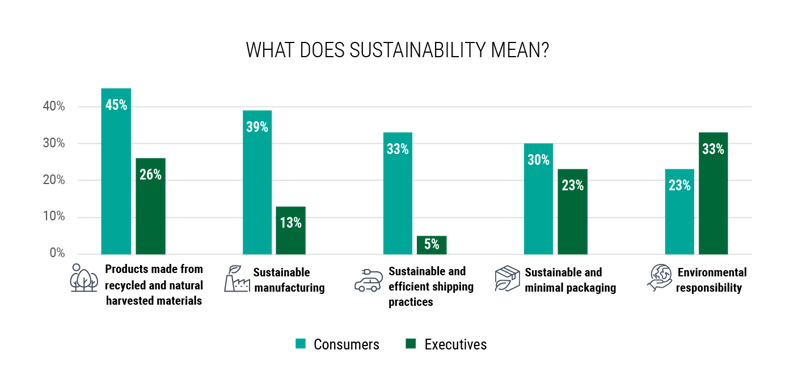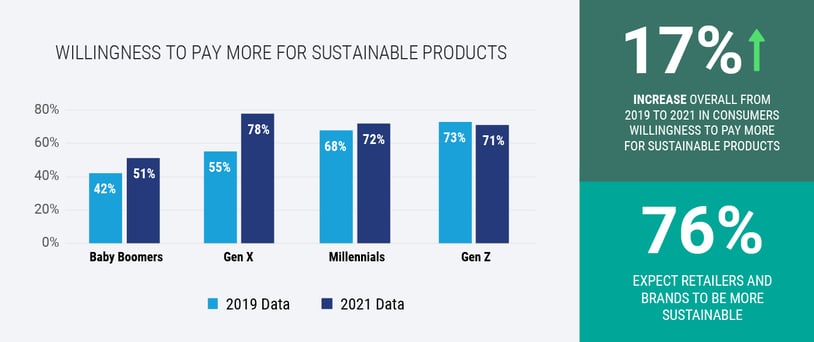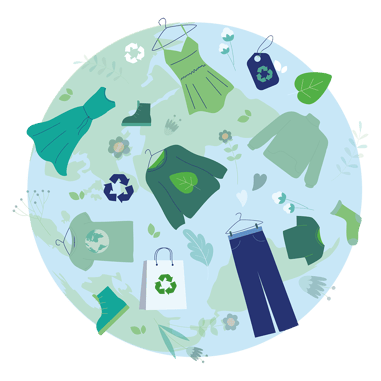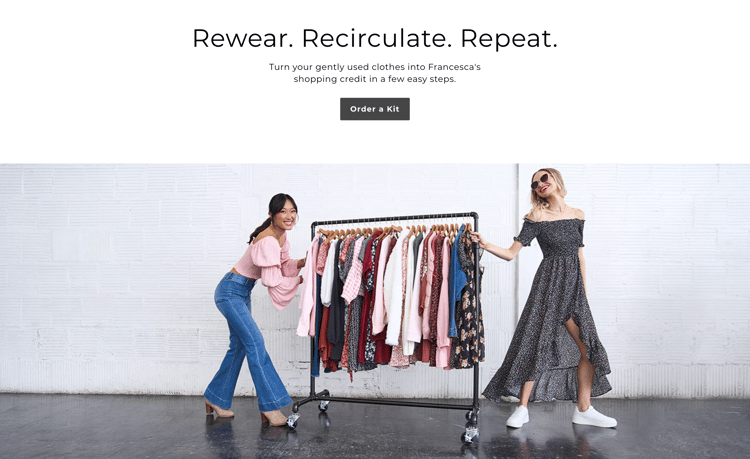The retail industry has long been recognized as a major contributor to environmental global and social challenges. However, as consumers become more conscious of the impact of their purchases, retailers are under increasing pressure to adopt sustainable practices and reduce their environmental footprint.
What Does Sustainability Mean to Consumers? Our Findings
According to several of our studies, consumers’ expectations for sustainable retail are influencing how they shop. We’ve found that consumers want to see retailers making a difference in the world, and they’re willing to pay more for products that reflect their values.
Consumer Adoption
In one of our reports, The State of Consumer Spending: Gen Z Shoppers Demand Sustainable Retail, 62 percent of Gen Z survey participants prefer to buy from sustainable brands, which is on par with Millennials. Interestingly, we saw a drop in sentiment amongst older generations. 54 percent of Gen X and 44 percent of the Silent Generation said they prefer to shop from brands touting sustainability.
Defining Sustainability
As part of a different study, we asked executives and consumers the same question, “What does sustainability mean to you?” and presented the following options: This study indicates that there is a significant disconnect between executives and consumers on the very definition of sustainability. Consumers selected “Products made from recycled, sustainable, and naturally harvested fibers and materials” as the most sought-after component at 45 percent, while only 26 percent of executives believe consumers define sustainability that way. This is a significant gap and one that highlights the disconnect between what consumers want and what brands are actually delivering.
This study indicates that there is a significant disconnect between executives and consumers on the very definition of sustainability. Consumers selected “Products made from recycled, sustainable, and naturally harvested fibers and materials” as the most sought-after component at 45 percent, while only 26 percent of executives believe consumers define sustainability that way. This is a significant gap and one that highlights the disconnect between what consumers want and what brands are actually delivering.
Sustainability's Influence on Shopping Behavior
We also partnered with the Baker Retailing Center at the Wharton School of the University of Pennsylvania to survey consumers on how sustainability impacts their shopping habits. The study found that Gen Z has an outsized influence on older generations when it comes to persuading them of the value of sustainability. As a result, the popularity of recommerce has skyrocketed across all generations, with 83% of US consumers overall utilizing secondhand shopping formats. Even Baby Boomers are 56% more likely to engage with recommerce—whether buying or selling—than they were just two years ago. Third-party marketplaces, like ThredUp or The RealReal, are used more by Millennial and Gen Z consumers than other demographic cohorts. Learn more about this form of resale in our blog, What is Recommerce?
As a result, the popularity of recommerce has skyrocketed across all generations, with 83% of US consumers overall utilizing secondhand shopping formats. Even Baby Boomers are 56% more likely to engage with recommerce—whether buying or selling—than they were just two years ago. Third-party marketplaces, like ThredUp or The RealReal, are used more by Millennial and Gen Z consumers than other demographic cohorts. Learn more about this form of resale in our blog, What is Recommerce?
Key Takeaway for Retailers: All of these studies point to the same thing: a company with a strong sustainability strategy can simultaneously meet consumers' demand for sustainable products and reap the rewards of a growing market.
Key Trends for Retailers to Look Out For
Sustainability in retail can encompass a wide range of practices and initiatives, from reducing waste and emissions to improving energy efficiency and sourcing sustainable materials. To help retailers navigate this complex landscape, we've compiled a guide to some of the most important sustainability trends and best practices in the retail industry.
♻️ Renewable Energy and Energy Efficiency
One of the most important sustainability trends in retail is the use of renewable energy and energy-efficient practices. Retailers can reduce their carbon footprint by investing in renewable energy sources, such as solar and wind power, and by implementing energy-efficient technologies in their stores, warehouses, and distribution centers. This can include things like using LED lighting, installing energy-efficient HVAC systems, and optimizing building insulation.
♻️ Reducing Waste
Another way that retailers are becoming more environmentally responsible is by reducing waste through recycling and composting programs, as well as implementing packaging materials that have a lower impact on the environment.
Retailers are reducing waste by using biodegradable or compostable packaging, switching to reusable shipping containers, and offering recycling programs for products at the end of their life, such as clothing and electronics.
♻️ Sustainable Materials
In addition to using recyclable materials and better power-management systems, more retailers are incorporating sustainable materials into their products. This can include things like organic cotton, recycled polyester, and other materials that are produced using more environmentally friendly methods. Retailers can reduce their environmental impact and appeal to more customers by using sustainable materials.
♻️ Circular Economy Principles
The circular economy is another trend that is gaining traction in sustainable retail. This approach aims to keep products and materials in use for as long as possible and minimize waste by repairing, renting, and reselling products. Retailers can reduce waste, extend the life of products, and appeal to consumers looking for more sustainable options by implementing programs that employ these tenets.
One way that retailers are embracing the circular economy is by offering repair and maintenance services for products such as shoes and electronics. This not only extends the life of products but also creates new business opportunities for retailers as they fulfill their customers' need for repair. These services keep customers happy and products out of the landfill while adding an entirely new profit center to the business.
♻️ Recommerce (also known as resale and secondhand shopping)
Another sustainable practice that is gaining popularity is recommerce. Recommerce is the practice of buying and selling used or secondhand goods. This is based on the idea of "reverse commerce" and "repeat commerce," where businesses and individuals can benefit from previously owned goods instead of allowing them to end up in a landfill. It delivers on all three elements of the famous "Reduce - Reuse - Recycle" trifecta.
As an example, francesca's, partnered with thredUP to launch forever francesca's, has recycled more than 20,000 pieces of its clothing through the program. The forever francesca’s platform allows customers to shop for secondhand apparel, shoes, and accessories online and resell pre-loved items of any brand for shopping credit.
♻️ Sustainable Supply Chain
Retailers aren't just looking at internal processes to solve their sustainability problems, they are investigating solutions throughout the supply chain. It's now common for companies to work with and in some cases, pressure suppliers to improve their environmental and social performance. These measures can include ensuring that raw materials are responsibly and sustainably sourced or implementing sustainable logistics and transportation methods. Participating in sustainable supply chain practices can reduce the environmental impact of a company while simultaneously improving its perception amongst its customers.
♻️ Transparency and Communication
Finally, a crucial step in sustainable retail is increasing transparency and customer communication about the company's sustainability efforts and progress. Companies can implement several practices to promote sustainability, such as releasing annual sustainability reports or highlighting specific initiatives on their websites and social media channels. This technique can help to make customers feel personally connected to your brand and encourage them to engage with sustainability initiatives.
By being transparent and communicative about sustainability, retailers can build trust with customers and demonstrate their commitment to making a positive impact.
Conclusion
Sustainability is more than just a buzzword. It’s here to stay as a forcing function in retail. Consumers are more environmentally conscious than ever before, and it’s time to get with the program. Understanding how to meet consumer demand is critical in today’s mission-driven environment. Learn how First Insight can help you incorporate the Voice of Your Customer to get the products your customers value to market faster and more sustainably.

















